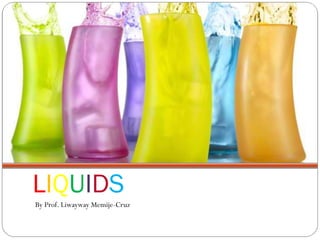Liquids
- 1. LIQUIDS By Prof. Liwayway Memije-Cruz
- 2. Liquids an intermediate phase between solid and gas. particles are subject to intermolecular attraction have more space between them, so they are not fixed in position. attraction between the particles in a liquid keeps the volume of the liquid constant.
- 3. Cohesion the tendency for the same kind of particles to be attracted to one another. Cohesive forces are greatest beneath the surface of the liquid, where the particles are attracted to each other on all sides. Particles at the surface are more strongly attracted to the identical particles within the liquid than they are to the surrounding air. This accounts for the tendency of liquids to form spheres, the shape with the least amount of surface area. When these liquid spheres are distorted by gravity, they form the classic raindrop shape.
- 4. Surface tension cohesive "stickiness" of the particles accounts for the surface tension of a liquid. a very thin "skin" of particles that are more strongly attracted to each other than they are to the particles surrounding them. As long as these forces of attraction are undisturbed, they can be surprisingly strong. the surface tension of water is great enough to support the weight of an insect such as a water skipper. Water is the most cohesive nonmetallic liquid.
- 5. Cohesive Work Environment increases the likelihood of employee satisfaction and serves as an incentive for employees to arrive prepared and willing to conquer the tasks of the day. Lack of cohesion within a working environment is certain to result in unnecessary stress and tension among coworkers. As might be expected, when employees do not get along together, work suffers. Cohesion in the work place could, ultimately, be the rise or demise of an organization or company’s success.
- 6. Adhesion When forces of attraction exist between different types of particles. Particles of a liquid will not only be attracted to one another, but they are generally attracted to the particles that make up the container holding the liquid. Particles of the liquid are drawn up above the surface level of the liquid at the edges where they are in contact with the sides of the container. The combination of cohesive and adhesive forces means that a slight concave curve, known as the meniscus, exists at the surface of most liquids. The most accurate measurement of the volume of a liquid in a graduated cylinder will be observed by looking at the volume marks closest to the bottom of this meniscus. Adhesion also accounts for capillary actions when a liquid is drawn up into a very narrow tube. One example of capillary action is when someone collects a sample of blood by touching a tiny glass tube to the blood droplet on the tip of a pricked finger.
- 7. Viscosity a measure of how much a liquid resists flowing freely. A liquid that flows very slowly is said to be more viscous than a liquid that flows easily and quickly. A substance with low viscosity is considered to be thinner than a substance with higher viscosity, which is usually thought of as being thicker. For example, honey is more viscous than water. Honey is thicker than water and flows more slowly. Viscosity can usually be reduced by heating the liquid. When heated, the particles of the liquid move faster, allowing the liquid to flow more easily.
- 8. Evaporation Because the particles of a liquid are in constant motion, they will collide with one another, and with the sides of the container. Such collisions transfer energy from one particle to another. When enough energy is transferred to a particle at the surface of the liquid, it will eventually overcome the surface tension holding it to the rest of the liquid. Evaporation occurs when surface particles gain enough kinetic energy to escape the system. As the faster particles escape, the remaining particles have lower average kinetic energy, and the temperature of the liquid cools. This phenomenon is known as evaporative cooling.
- 9. Volatility It can be thought of as how likely a substance will be to vaporize at normal temperatures. Volatility is more often a property of liquids, but some highly volatile solids may sublime at normal room temperature. Sublimation happens when a substance passes directly from solid to gas without passing through the liquid state.

